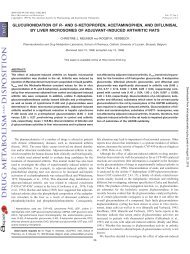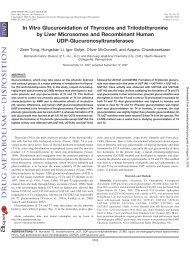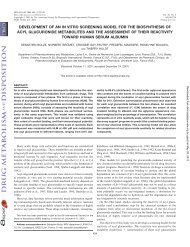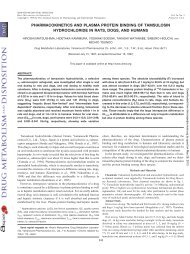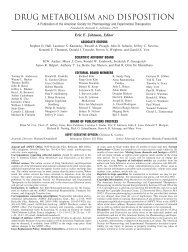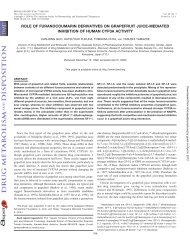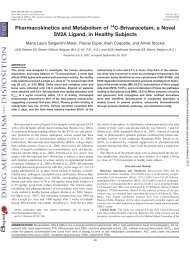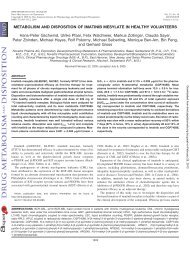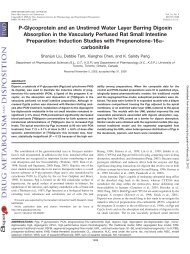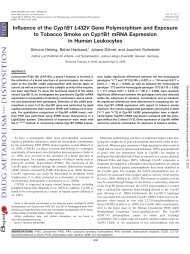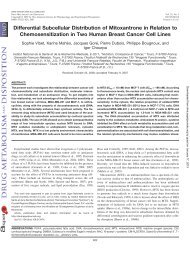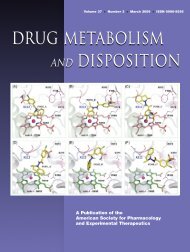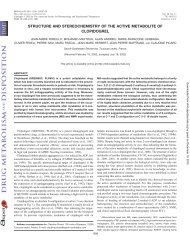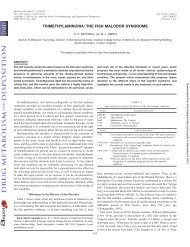metabolism of diallyl disulfide by human liver microsomal ...
metabolism of diallyl disulfide by human liver microsomal ...
metabolism of diallyl disulfide by human liver microsomal ...
You also want an ePaper? Increase the reach of your titles
YUMPU automatically turns print PDFs into web optimized ePapers that Google loves.
DIALLYL DISULFIDE METABOLISM BY HUMAN LIVER MONOOXYGENASES<br />
FIG. 4.Inhibition <strong>of</strong> DADS oxidation <strong>by</strong> chemical CYP inhibitors in <strong>human</strong> <strong>liver</strong> microsomes.<br />
Values are the percentage <strong>of</strong> control (without inhibitor). They are expressed as means � S.E.M. <strong>of</strong> four <strong>human</strong> samples.<br />
TABLE 4<br />
Inhibitory effects <strong>of</strong> various compounds on PNPH activity<br />
Values are the percentages <strong>of</strong> control activity (without inhibitor) and are means � S.E.M.<br />
<strong>of</strong> four <strong>human</strong> samples (KS27, KS30, KS44, and KS52).<br />
Compound PNPH Activity<br />
Tranylcypromine, 30 �M 21.3 � 1.0<br />
Coumarin, 22 �M 39.0 � 1.5<br />
Coumarin, 200 �M 34.6 � 1.8<br />
FIG. 5.Michaelis-Menten plot for the oxidation <strong>of</strong> DADS <strong>by</strong> <strong>human</strong><br />
cDNA-expressed CYP microsomes.<br />
Values are means <strong>of</strong> duplicate.<br />
Discussion<br />
We have studied the <strong>metabolism</strong> <strong>of</strong> DADS in the presence <strong>of</strong><br />
<strong>human</strong> <strong>liver</strong> microsomes and we have observed the appearance <strong>of</strong><br />
DADSO formed <strong>by</strong> the oxidation <strong>of</strong> one sulfur atom. Both DADS and<br />
TABLE 5<br />
Kinetic parameters <strong>of</strong> DADS oxidation <strong>by</strong> cDNA-expressed <strong>human</strong> CYP or<br />
FMO microsomes<br />
Values are the means <strong>of</strong> two determinations.<br />
Enzyme K m V max V max/K m<br />
mM pmol/min/pmol enzyme<br />
CYP1A2 nd nd<br />
CYP2A6 0.33 20.9 63.3<br />
CYP2C8 2.03 3.8 1.87<br />
CYP2C9 0.50 5.2 10.4<br />
CYP2C19 1.71 96.3 56.3<br />
CYP2D6 1.12 121 108.0<br />
CYP2E1 0.03 60.3 2010<br />
CYP3A4 nd nd<br />
CYP4A1 nd nd<br />
Control nd nd<br />
FMO3 10.15 41.9 4.13<br />
nd, not determined in absence <strong>of</strong> any activity.<br />
839<br />
DADSO are natural compounds found in crushed garlic but the latter<br />
has been considered as the most important biologically active compound<br />
<strong>of</strong> garlic (Reuter, 1995; Augusti, 1996). Among several sulfides<br />
from Allium studied, DADS exhibited in vivo the strongest<br />
anticarcinogenic properties (Ip et al., 1992; Haber-Mignard et al.,<br />
1996) and protected against carcinogen-induced DNA strand breaks<br />
(Le Bon et al., 1997). These effects were attributed to in vivo modulation<br />
<strong>of</strong> hepatic drug-metabolizing enzymes <strong>by</strong> DADS (Haber et al.,<br />
1994). Knowing the in vitro DADS <strong>metabolism</strong>, we suppose that the<br />
in vivo effects <strong>of</strong> DADS are in fact due to DADSO.<br />
In this study, we have observed the oxidation <strong>of</strong> DADS to sulfoxide.<br />
The in vivo <strong>metabolism</strong>s <strong>of</strong> <strong>diallyl</strong> sulfide (DAS; Brady et al.,<br />
1991, Chen et al., 1994) and <strong>of</strong> dipropyl sulfide (Nickson and Mitchell,<br />
1994), two sulfur compounds from Allium, implicate a first step <strong>of</strong><br />
oxidation to form a sulfoxide and a second one to form a sulfone. With<br />
DADS two steps <strong>of</strong> oxidation were not excluded, even if formation <strong>of</strong><br />
<strong>diallyl</strong> thiosulfonate (DADSO 2) was not observed in the incubation<br />
medium. In fact we have characterized DADSO as a mechanismbased<br />
inactivator <strong>of</strong> CYP2E1 (results not published). This should<br />
mean that DADSO could be oxidized to a reactive species (possibly<br />
Downloaded from<br />
dmd.aspetjournals.org <strong>by</strong> guest on November 24, 2012



